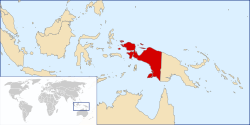Our website is made possible by displaying online advertisements to our visitors.
Please consider supporting us by disabling your ad blocker.
Dutch New Guinea
This article needs additional citations for verification. (April 2024) |
Dutch New Guinea Nederlands-Nieuw-Guinea | |||||||||||
|---|---|---|---|---|---|---|---|---|---|---|---|
| 1949–1962 | |||||||||||
| Motto: Setia, Djudjur, Mesra (Indonesian) Pius, Honestus, Amica (Latin) "Loyal, Honest, Affectionate" | |||||||||||
| Anthem: "Wilhelmus van Nassouwe" (Dutch) (English: "William of Nassau") Hai Tanahku Papua (Indonesian) (English: "Oh My Land Papua") | |||||||||||
 Map of the Dutch possession in the New Guinea | |||||||||||
| Status | Colony of the Netherlands (1949–1954) Overseas territory of the Kingdom of the Netherlands (1954–1962) | ||||||||||
| Capital | Hollandia | ||||||||||
| Common languages | Dutch Papuan Malay Papuan languages Austronesian languages | ||||||||||
| Religion | Christianity Animism (folk / ethnic) | ||||||||||
| Government | Colonial administration | ||||||||||
| Monarch | |||||||||||
• 1949–1962 | Juliana | ||||||||||
| Governor | |||||||||||
• 1950–1953 (first) | Stephan Lucien Joseph van Waardenburg | ||||||||||
• 1958–1962 (last) | Pieter Johannes Platteel | ||||||||||
| Historical era | Cold War | ||||||||||
• Established | 27 December 1949 | ||||||||||
• Disestablished | 1 October 1962 | ||||||||||
| Area | |||||||||||
• Total | 421,981 km2 (162,928 sq mi) | ||||||||||
| Population | |||||||||||
• 1955 | 321,000 | ||||||||||
| Currency | NNG gulden | ||||||||||
| |||||||||||
| Today part of | Indonesia | ||||||||||

Dutch New Guinea or Netherlands New Guinea (Dutch: Nederlands-Nieuw-Guinea, Indonesian: Nugini Belanda) was the western half of the island of New Guinea that was a part of the Dutch East Indies until 1949, later an overseas territory of the Kingdom of the Netherlands from 1949 to 1962. It contained what are now Indonesia's six easternmost provinces, Central Papua, Highland Papua, Papua, South Papua, Southwest Papua, and West Papua, which were administered as a single province prior to 2003 under the name Irian Jaya, and now comprise the Papua region of the country.
During the Indonesian Revolution, the Dutch launched politionele acties to capture territory from the Indonesian Republic. However, the harsh methods of the Dutch had drawn international disapproval. With international opinion shifting towards support of the Indonesian Republic, the Dutch managed in 1949 to negotiate for the separation of Dutch New Guinea from the broader Indonesian settlement, with the fate of the disputed territory to be decided by the close of 1950. However, the Dutch in coming years were able to argue successfully at the UN that the indigenous population of Dutch New Guinea represented a separate ethnic group from the people of Indonesia and thus should not be absorbed into the Indonesian state.
In contrast, the Indonesian Republic, as successor state to the Netherlands East Indies, claimed Dutch New Guinea as part of its natural territorial bounds. The dispute over New Guinea was an important factor in the quick decline in bilateral relations between the Netherlands and Indonesia after Indonesian independence. The dispute escalated into low-level conflict in 1962 following Dutch moves in 1961 to establish a New Guinea Council.
Following the Vlakke Hoek incident, Indonesia launched a campaign of infiltrations designed to place pressure on the Dutch. Facing diplomatic pressure from the United States, fading domestic support and continual Indonesian threats to invade the territory, the Netherlands decided to relinquish control of the disputed territory in August 1962, agreeing to the Bunker Proposal on condition that a referendum to determine the final fate of the territory be conducted at a later date. The territory was administered by the UN temporarily before being transferred to Indonesia on 1 May 1963. A plebiscite, the Act of Free Choice, was eventually held in 1969, but the fairness of the election is disputed.
Previous Page Next Page





